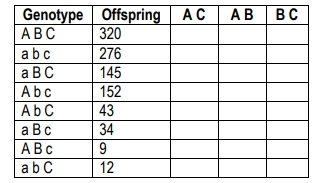Domestic dogs evolved from ancestral gray wolves. Wolves have coats of short, straight hair and lack 'furnishings,' a growth pattern marked by eyebrows and a mustache found in some domestic dogs. In domestic dogs, coat variation is controlled by allelic variation in three genes. Recessive mutant alleles in the FGF5 gene result in long hair, while dogs carrying the dominant ancestral allele have short hair. Likewise, recessive mutant alleles in the KRT71 gene result in curly hair, whereas dogs with an ancestral dominant allele have straight hair. Dominant mutant alleles in the RSPO2 gene cause the presence of furnishings, while dogs homozygous for the ancestral recessive allele have no furnishings. A pure-breeding curly- and long-haired poodle with furnishings was crossed to a pure-breeding short- and straight-haired border collie lacking furnishings
If dogs of the F₁ generation are interbred, what proportions of genotypes and phenotypes are expected in the F₂?
Table of contents
- 1. Introduction to Genetics51m
- 2. Mendel's Laws of Inheritance3h 37m
- 3. Extensions to Mendelian Inheritance2h 41m
- 4. Genetic Mapping and Linkage2h 28m
- 5. Genetics of Bacteria and Viruses1h 21m
- 6. Chromosomal Variation1h 48m
- 7. DNA and Chromosome Structure56m
- 8. DNA Replication1h 10m
- 9. Mitosis and Meiosis1h 34m
- 10. Transcription1h 0m
- 11. Translation58m
- 12. Gene Regulation in Prokaryotes1h 19m
- 13. Gene Regulation in Eukaryotes44m
- 14. Genetic Control of Development44m
- 15. Genomes and Genomics1h 50m
- 16. Transposable Elements47m
- 17. Mutation, Repair, and Recombination1h 6m
- 18. Molecular Genetic Tools19m
- 19. Cancer Genetics29m
- 20. Quantitative Genetics1h 26m
- 21. Population Genetics50m
- 22. Evolutionary Genetics29m
4. Genetic Mapping and Linkage
Trihybrid Cross
Struggling with Genetics?
Join thousands of students who trust us to help them ace their exams!Watch the first videoMultiple Choice
The following table shows data from a cross examining three genes (a, b, and c). Determine the order of genes

A
A B C
B
B C A
C
C A B
 Verified step by step guidance
Verified step by step guidance1
Examine the table to identify the parental genotypes and the number of offspring for each genotype. The parental genotypes are typically the ones with the highest number of offspring, which in this case are 'A B C' and 'a b c'.
Identify the double crossover genotypes, which are usually the ones with the lowest number of offspring. In this table, 'A B c' and 'a b C' have the lowest numbers, indicating double crossovers.
Determine the gene order by comparing the parental and double crossover genotypes. The gene that differs between the parental and double crossover genotypes is the middle gene. For example, if 'A B C' and 'a b c' are parental, and 'A B c' and 'a b C' are double crossovers, the gene that changes is 'B', suggesting 'B' is in the middle.
Use the single crossover genotypes to confirm the gene order. Single crossovers will have intermediate numbers of offspring and will show recombination between adjacent genes. Check the genotypes 'a B C', 'A b c', 'A b C', and 'a B c' to see which gene combinations are most frequent.
Conclude the gene order based on the analysis of parental, single crossover, and double crossover genotypes. The gene order is determined by the gene that changes in the double crossover and is confirmed by the single crossover patterns.
Related Videos
Related Practice
Open Question
Trihybrid Cross practice set




